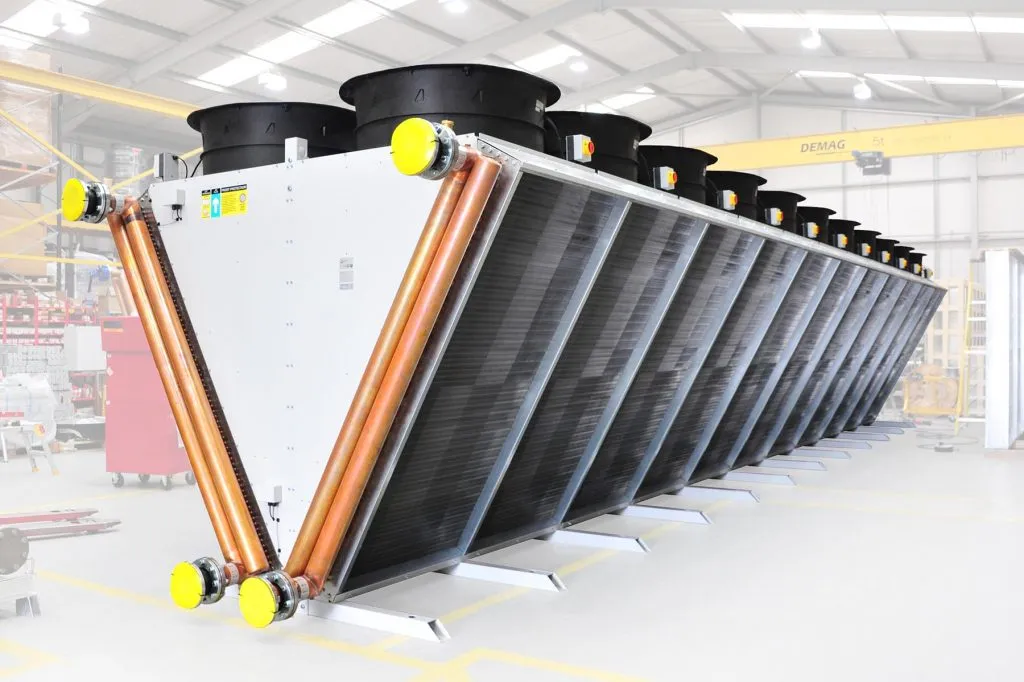Air Blast Cooling is a type of dry cooling method where ambient air is used to remove heat from equipment, fluids, or surfaces. It utilizes high-velocity air blown over heated surfaces, finned tubes, or coils to lower temperatures effectively. Unlike water cooling, this method doesn’t rely on a liquid medium to transfer heat but uses the natural heat-carrying capacity of air, accelerated through fans or blowers. This technique is especially popular in industries where water is scarce, environmental concerns are high, or low maintenance is a priority. It provides a reliable and cost-effective way to control temperatures in industrial and electrical systems.
Major Components of Air Blast Cooling Systems
- Fans or Blowers: These are usually axial or centrifugal fans that create a strong airflow. Axial fans are used for high flow, while centrifugal fans are suited for higher pressure applications.
- Cooling Coils or Tubes: Hot fluids like oil or coolant pass through these coils. They’re often constructed from copper, aluminum, or stainless steel due to their thermal conductivity and corrosion resistance.
- Fins: Attached to coils or tubes, fins help in expanding the surface area that comes in contact with air. This increased surface accelerates heat transfer from the fluid to the air.
- Motor: Drives the fans or blowers and is typically electric. Motors are selected based on power requirements, airflow demand, and operational environments (e.g., flameproof motors for hazardous areas).
- Housing and Frame: Encloses and supports all other components. It’s designed for airflow optimization and easy maintenance access.
Industrial and Commercial Applications
Air Blast Cooling is used across a wide range of industries, especially where dry, low-maintenance, and non-water-based cooling is required:
- Hydraulic Oil Cooling: Extensively used in hydraulic presses, mobile machinery, and injection molding machines to maintain oil temperature within safe operating limits.
- Air Compressor Cooling: Reduces the temperature of compressed air, preventing moisture condensation and damage to downstream equipment.
- Transformer Cooling: Helps in maintaining transformer winding and oil temperatures, especially in remote power stations where water cooling isn’t feasible.
- CNC Machines & Tooling Systems: Ensures that hydraulic oil and spindle motors don’t overheat during continuous operation, ensuring machining precision and tool life.
- Plastic Injection Molding Equipment: Keeps hydraulic systems within operating temperatures, avoiding damage to seals and reducing cycle time.
Important Considerations
When designing or selecting an air blast cooler, the following aspects are important:
- Ambient Air Temperature: As the system uses surrounding air, cooling capacity drops in hot environments. In such cases, increasing airflow or adding more surface area is needed.
- Air Flow Direction: Proper air routing prevents hot air recirculation and ensures optimal performance.
- Noise Level: Industrial fans can generate noise; acoustic enclosures or silencers may be needed in sensitive environments.
- Maintenance Access: Ensure the design allows easy access to clean fan blades, coils, and motors.
- Fan Speed Control: Variable speed drives can help in adjusting cooling capacity based on demand, saving energy.
Air Blast Cooling is an intelligent choice for industries and systems that need reliable, consistent cooling without the cost and complexity of water-based systems. It’s ideal for remote locations, portable equipment, and facilities aiming to reduce water use, operational costs, and environmental footprint. While its cooling capacity is limited compared to chilled water systems, its benefits in reliability, safety, and simplicity make it an excellent solution for many modern applications.
